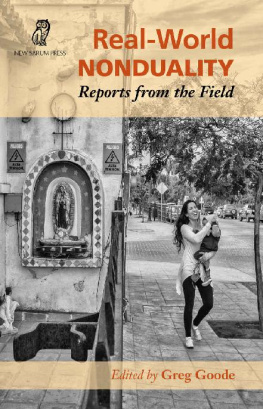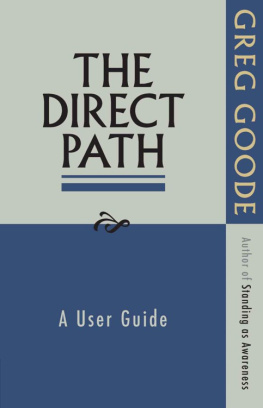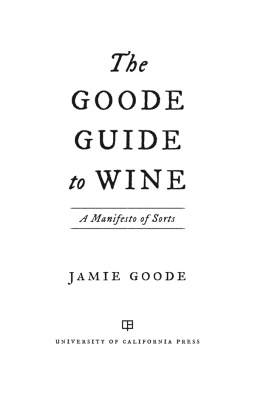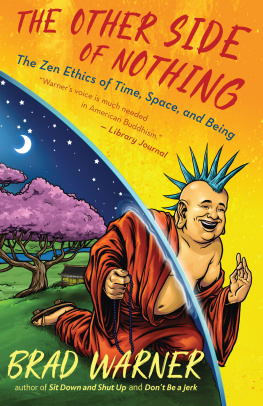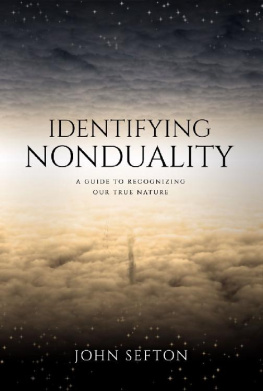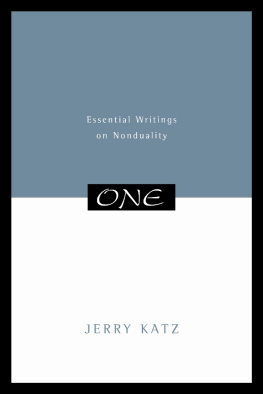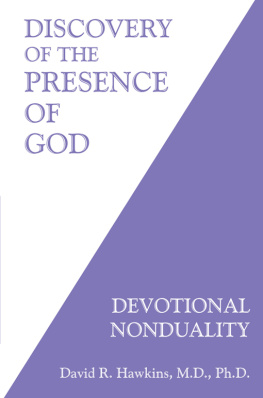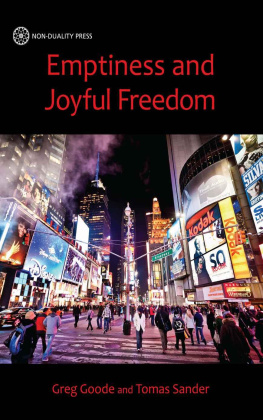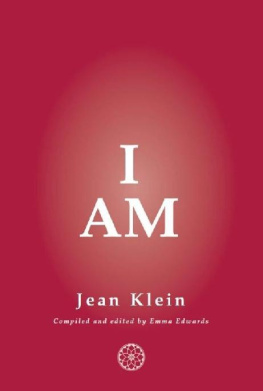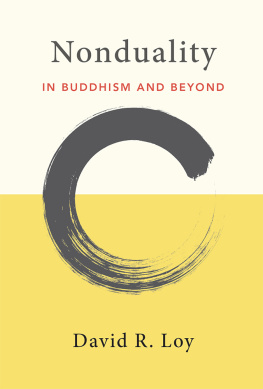Real-World
Nonduality
Reports from the Field
NEW SARUM PRESS
UNITED KINGDOM
New Sarum Press, 6 Folkestone Road, Salisbury, SP2 8JP United Kingdom www.newsarumpress.com Copyright New Sarum Press 2018 First printing December 2018 ISBN: 978-1-9993535-1-3 Cover image:
My Child Is My World by Robert Saltzman
Table of Contents
Introduction
by Greg Goode
Many years ago I attended a week-long retreat given by a well-known teacher of nonduality. There was a group of psychotherapists present, and this was their first exposure to the message of nonduality. I happened to be sitting near them during the morning break. They were excited but confused, and I heard a bit of their discussion.
This changes everything.
We must completely rethink psychotherapy.
Lets have an emergency meeting after lunch.
This happened almost two decades ago, before the advent of the specialty sometimes called nondual psychotherapy. Its just one example of what happens when everyday life encounters nonduality.
This is a book of essays by new writers about how their encounters with nonduality have impacted their lives (see Note from 2018). Ill say more about nonduality below, but briefly, I mean the intimacy and inseparability of things. For many people, as well as those psychotherapists, the first encounter with nonduality can feel shocking.
What about the other areas of life? Those areas are what this book is about. The essays here discuss what happens to a wide variety of life situations when nonduality enters the picture: career, parenting, traditional religion, addiction, disease, death, perception, thought, and the very idea of being enlightened.
The Direct Path Approach to Nonduality
There are many possible approaches to nonduality. The approach referred to in these essays is the direct path teaching that flows from Sri Atmananda (Krishna Menon) and those who have been influenced by his work, including Jean Klein, John Levy, Ananda Wood, Francis Lucille, Rupert Spira, myself, and a few others. Ive included a short reading list at the end of this collection.
We will be discussing how this approach and the insights that come with it may be woven into daily life. It is deeply experiential, not theoretical. It begins with the intuition of a sweet, abiding clarity that seems to lie behind experiences and seems to illuminate at least the pleasant ones. We bring our attention to this clarity in various ways, such as self-inquiry, body-sensing yoga, resting as awareness, mini-reminders, guided meditation, and even long walks. We discover that clarity and sweetness illuminate all experiences. This is because clarity is the nature of experience. And sweetness is the aroma of clarity.
Im sure that essays like the ones in this book could be written about many other varieties of nondual teaching as well. The direct path is just one way to talk about nonduality. It is not new or unique.
Regular people tell it like it is
But this book does offer something new. It offers a series of views from the trenches. The writers are new at writing about nonduality. They are not claiming enlightenment. They are not writing from the perspective of a guru or satsang teacher. They are regular people writing in a down-to-earth way about how nonduality has impacted their lives. They are discussing situations faced by students of nonduality everywere.
This approach is different. It may even be revolutionary. Many texts on this subject are written in a mountaintop style, as though the author has ascended to some important level, proclaiming down to the reader. If Martians were to land on earth and examine the average nonduality library, theyd conclude that this is the only way to communicate.
Several of our writers have noticed this too. In discussing their backgrounds with me, they mentioned being told by teachers that, only the enlightened should write about spiritual topics. The argument goes that if anyone else tried, theyd cause a loss of purity. This would result in the blind leading the blind.
We are ignoring these directives, for several good reasons. First, what is being said when a teacher utters these things?
I am enlightened and pure; I can write about these things. You arent, so you cant.
Besides sounding arrogant and narcissistic, this pronouncement takes itself seriously. It assumes a world view that nondual inquiry subjects to deep scrutiny. Nonduality examines the idea of an enlightened or unenlightened person and finds the idea to be nonsense. This is primarily because the more we search for who is enlightened or unenlightened, the less we find. And secondarily, most nonduality teachings caution us against taking seriously the adjectives enlightened and unenlightened. These labels are like any others, such as teacher, student, or construction worker. Even if they function in practical, day-to-day matters, they fail to refer to anything findable, anything really present.
We are ignoring these anti-writing directives mainly because theres no way to put communication in a box. No one can control it. Spiritual writing is already too vast. Writing to teach, to lead, is just one mode. We have teacherly tomes in nonduality, some of which I have written. We have masterful collections of dialogues with Ramana Maharshi, Nisargadatta Maharaj, and Sri Atmananda (Krishna Menon).
But communication doesnt have to be didactic. For example, Buddhism has generated many modes of spiritual writing. But as far as I know, nonduality has nothing that parallels wor
I simply cant find any reason that reportorial, confessional, and observant pieces like these shouldnt exist in the field of nonduality. Perhaps this book is a small start. Readers may find it a useful springboard to look at nonduality from different angles or learn that someone else is experiencing the same issues they are going through.
In the next section you will find synopses of the essays that follow. Ive chosen a rough order that proceeds from more concrete issues to more abstract ones.
Note from 2018
Writing in November 2018, I look back and see that this book has been in the works for more than three years. Its been a coordinated effort among writers, editors and proofreaders. Because the group consisted of new, unpublished writers, we even enlisted the services of a professional writing coach (along with yours truly) to help those who requested it. In the early days, we even had exercises and practice assignments!
Since the project began in July, 2015, weve had life changes, illnesses, recuperations, and death in the family. People have moved house, changed their day jobs, retired, taken up hobbies and passionate new interests in life. And some people have begun writing, publishing and conducting spiritual teaching. I mention this because when the project began all our contributors were indeed new writers. But by the time this book became available, several have been writing and sharing elsewhere.
Note on UK English and US English Spelling
Individual essays may have USA or UK English spelling, as appropriate to each authors background.
About the proceeds
We will be donating the proceeds from this book to the Centre Against Abuse in Bermuda ( www.centreagainstabuse.bm ).
Kamenetz, R. (2009)
The Jew in the Lotus: A Poets Rediscovery of Jewish Identity in Buddhist India, Harper One Dreyfus, G. (2003)
Next page
